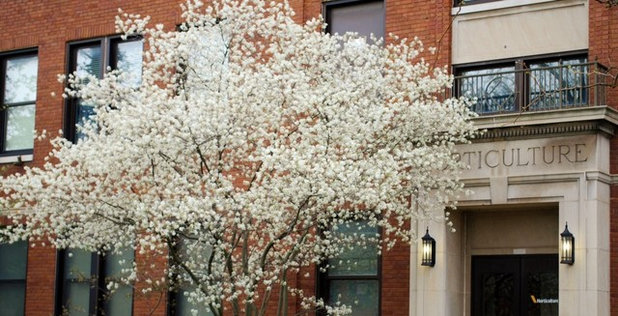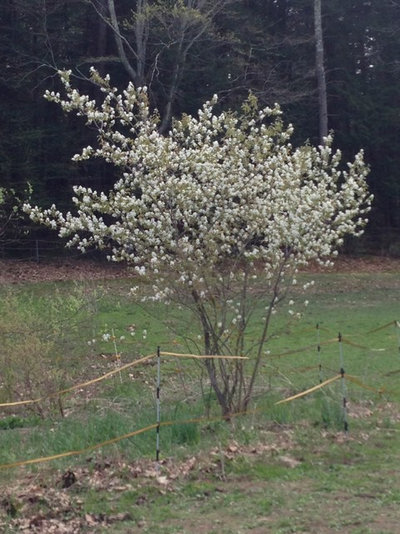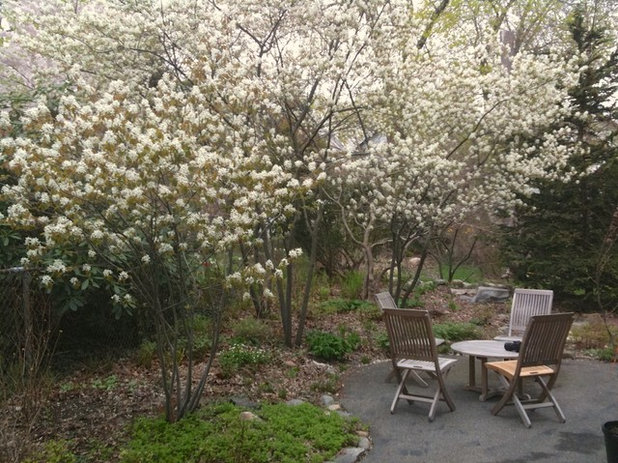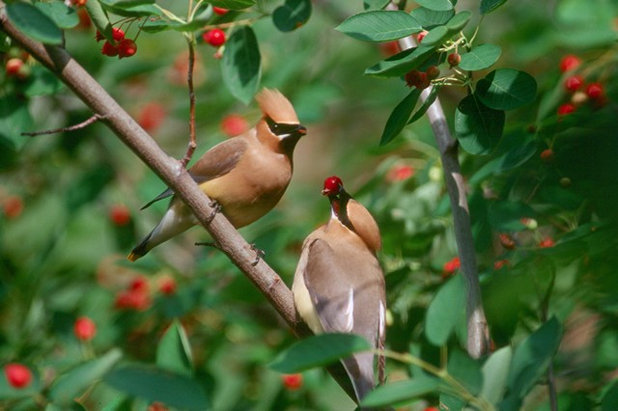The beautiful white clouds of serviceberries (
Amelanchier spp) in bloom are one of the first signs of spring here in central Massachusetts, flowering in the New England woods in mid-April, even before the daffodils bloom. Serviceberries are traditionally known as shadbush in the U.S. East, because they bloom when shad fish migrate up freshwater rivers from Eastern coastal waters to spawn.
Amelanchier species are fast-growing shrubs and trees loaded with resources for birds, butterflies and early-season pollinators. They grow across North America, with species suitable for sun or shade, and moist or dry soil, depending on your part of the country.

GardenArt
Botanical name: Amelanchier spp
Common names: Shadblow, shadbush, serviceberry, juneberry
Origin: There are species native to eastern and western parts of the U.S.
Where it will grow: Various species are hardy to -50 degrees Fahrenheit (USDA zones 2 to 9; find your zone)
Water requirement: Varies by species
Light requirement: Varies by species
Soil requirement: Wet to dry, depending on species
Mature size: 1 to 50 feet tall, depending on species
Benefits and tolerances: Fast growth; early blooms; edible fruits; important native plant for birds and bees
Seasonal interest: Early-spring blooms (April in southern New England); colorful fruits ripen to red, blue or purple in June (hence the common name juneberry); orangey-red or yellow fall foliage in the eastern species
When to plant: Spring to fall

Ellen Sousa/Turkey Hill Brook Farm
Distinguishing traits. There are roughly 20 species of Amelanchier native to the U.S., and because they freely hybridize in the wild and in cultivation, they can be difficult to identify. Mostly you’ll find hybrids of the various regional native species for sale in U.S. nurseries. Because their habitat varies by region, be sure to look for a species or cultivar that is suitable for your region’s climate and your garden’s conditions.
In the eastern U.S., hybrids and cultivars of Canada serviceberry (
A. canadensis), downy serviceberry (
A. arborea) and Allegheny smooth serviceberry (
A. laevis) are often sold as
A x
grandiflora, with names such as ‘Autumn Brilliance’, ‘Snowcloud’ and ‘Robin Hill’. These are attractive multi- or single-stemmed understory or specimen trees that grow 10 to 30 feet tall, depending on the amount of light and soil moisture. They generally do best in wet or boggy soils but will grow in drier soils if irrigated for the first year or two. The eastern serviceberries bloom and fruit most heavily in full sun, but as understory trees in the wild, they will happily bloom in the shade of deciduous trees. Eastern species grow in zones 4 to 9.
In the west, Saskatoon serviceberry (
A. alnifolia) grows wild across Canada and in western America south to Colorado. It reaches 4 to 10 feet tall and wide and features 1-inch purple fruits that look just like blueberries. Saskatoon serviceberry prefers the neutral soils and the dry sun of the west over the humid conditions of the east and is readily available in western U.S. nurseries that sell native plants. Saskatoon serviceberry grows in zones 2 to 6.
There are also low, suckering “dwarf” serviceberry species, including
Amelanchier bartramiana,
A. sanguinia,
A. spicata and
A. stolonifera,
that grow in drier soils across the continent, often seen in the wild on rocky ledges and outcrops. These ground-covering flowering shrubs, usually reaching 1 foot to 6 feet tall, mix well with lowbush blueberry (
Vaccinium angustifolium) and other natives that like the same conditions. These plants grow in zones 3 to 9, but you will have to search out local native-plant nurseries to find them for sale.

Ellen Sousa/Turkey Hill Brook Farm
How to use it. In eastern climes, create a cool, shady retreat for summertime enjoyment by scattering Canada serviceberries in and among existing trees and underplanting it with low woodland natives, such as wild ginger (
Asarum canadense), wood anemone (
Anemone quinquefolia), Dutchman’s breeches (
Dicentra cucullaria) and foamflower (
Tiarella cordifolia).
Both the eastern and western serviceberries can be pruned into beautiful flowering lawn trees, or use them as an early-season component in a flowering songbird hedge, along with spicebush (
Lindera benzoin), shrubby dogwood (
Swida spp, formerly
Cornus),
Viburnum spp,
Rhododendron spp, holly (
Ilex spp) and cherry (
Prunus spp) trees.
Serviceberry makes a great substitute for Asian flowering pear trees (
Pyrus calleryana) — commonly planted landscaping trees that are highly susceptible to storm damage. The native serviceberry blooms around the same time but has a built-in tolerance to the early- and late-season snowfalls that cause stem breakage on some less adapted exotic plants.
Shown: Serviceberries blooming in April in a peaceful Cambridge, Massachusetts, shade garden
 Wildlife value.
Wildlife value. April flowers feed hungry early-season bees, and June berries (pomes) are a top food source for birds, as hungry and tired migrants arrive in the north to breed and nest. Rose-breasted grosbeaks, northern cardinals, bluebirds and cedar waxwings (shown here) are all birds that relish the fruits.
The sweet fruits are popular with people too — the western species’ fruits make excellent jelly, and Native Americans used serviceberries to make a dried food called
pemmican,
which they stored as a winter food source. If you do you want to enjoy any of these delicious fruits, you’ll have to pick them before the birds find them and gobble them all up.
The twiggy structure of serviceberry also makes it a popular choice with nest-building songbirds. Those bird parents will find plentiful caterpillars to feed their hungry nestlings, as serviceberry is an important host plant for diverse butterfly and moth caterpillars, including admirals, viceroys, swallowtails and hairstreaks.
Planting notes. Mulch eastern species with leaf mold to help retain soil moisture. Although serviceberry can be prone to various leaf ailments, don’t kill off beneficial insects by spraying the plants.
Pruning. You can control the size and height of shrubby species by pruning one-third of the oldest stems to the ground each year for three years. Healthy plants can withstand quite a bit of leaf damage, and losing some leaves won’t harm them.
Occasionally prune out old stems to reduce disease carryover, and choose a serviceberry native to your region for best performance.
More: Browse plants native to other regions of the U.S.





